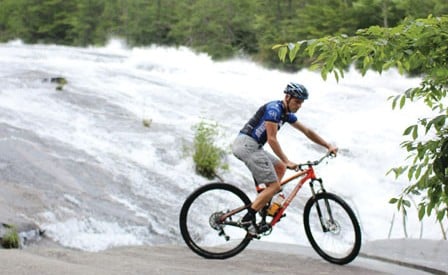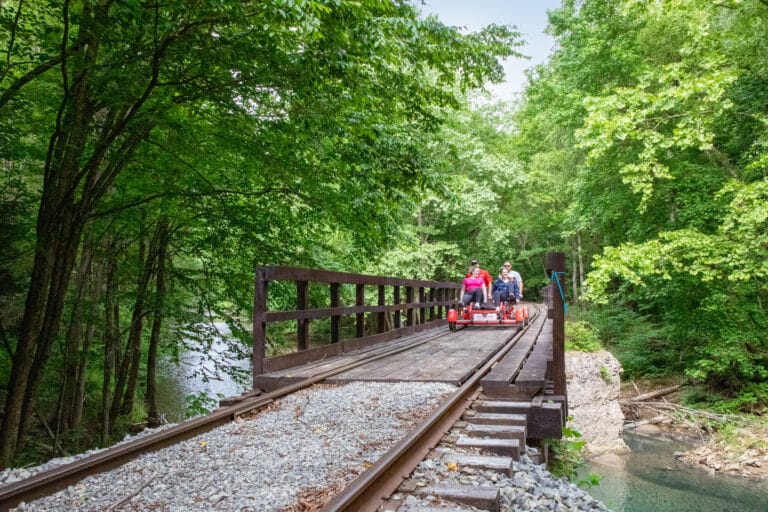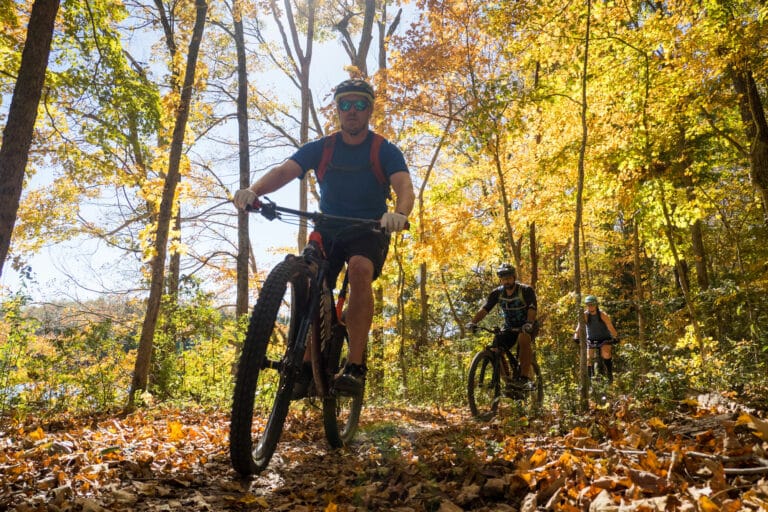Transylvania County in North Carolina is not home to any of Vlad Dracula’s ruthless ancestors. Transylvania’s Latin root actually means “exceedingly forested.” With 100,000 acres of public land, 400 miles of pristine singletrack, and more than 1,000 miles of gravel Forest Service roads, Transylvania offers endless biking opportunities. It also offers something equally treasured: more than 250 waterfalls.
DuPont State Forest is one of three forest parks that constitute those 100,000 acres of public land in Transylvania County, and although nearby Pisgah National Forest has long been recognized as Transylvania’s go-to for mountain biking, DuPont is quickly building its own reputation as a two-wheel destination. Both younger and smaller than Pisgah, DuPont is home to over 90 miles of interweaving singletrack and six impressive waterfalls. If you are unfamiliar with the forest, you have more than likely seen its cascades on the big screen in The Hunger Games and Last of the Mohicans.
Transylvania’s long history of recreation in and around its waterfalls predates the Civil War, but only 13 years ago the iconic sites of DuPont were once in jeopardy of being lost altogether to development. How the did Transylvania community rescue its oasis of waterfalls and singletrack?
Fourscore and 370 million years ago
DuPont’s waterfalls formed approximately 450 million years ago, when an island chain crashed into the North American continent near Dillsboro, N.C., and caused the first of three upheavals that would dramatically alter Transylvania’s landscape. According to Dr. James Reynolds, a geology professor at Brevard College, the islands slid to a stop near present-day DuPont where Brevard, the county seat, is located.
Millions of years later, a second collision occurred when another island chain hit North America farther south. While these preliminary crashes were instrumental in creating Transylvania’s mountainous terrain, it wasn’t until the continent of Africa collided with North America that the modern Blue Ridge Mountain range was formed.
“The rivers and their watershed were here long before the mountains,” says Reynolds. “At one time, these mountains were taller than the Himalayas. The rivers cut down the mountains.”
Because of Africa’s collision, the rivers in western North Carolina tend to run westward through the mountains instead of emptying into the ocean to the east.
“There are all sorts of fractures and minor faults throughout the mountains,” Reynolds continues. “The rivers are exploiting those zones of weakness, which is why we have all these waterfalls.”
Despite the Brevard Fault’s extensive geographical coverage, it has shown no problematic seismic activity for hundreds of years. Reynolds says High Falls in DuPont State Forest has the most abundant evidence that its waters are surging over an inactive fault. These faults can be recognized by the various bits of ground particles that are embedded in the primarily gneiss rock that constitutes the area east of the Brevard Fault.
“Save the falls for the people.”
In the early 1920s, the area encompassing present-day DuPont State Forest was known as Buck Forest and bustled with well-to-do members of its namesake, the Buck Forest Club. The men and their families explored the lush forests and plentiful waterways for hunting, fishing and elaborate picnics.
Then DuPont Corporation purchased Buck Forest in 1956, to begin a silicon crystal plant. When the market changed and the necessity of silicon waned, DuPont switched to producing sensitive X-ray films and became the first factory in the country to make it on polyester film.
DuPont sold the majority of its property to the state in 1997. The state initially bought only 7,600 acres from DuPont Corporation. The heart of the forest, though, a tract of land over 2,200 acres in size and housing three of the region’s most spectacular waterfalls, was sold to a Houston-based investment firm, who in turn sold it to South Carolina developer Jim Anthony. Anthony initially claimed that the waterfalls would remain untouched, but when he announced his intentions to build a gated community of expensive homes centered on the falls, the locals were furious.
“The falls had friends, then and now,” says Mac Morrow, a Brevard city councilman. “They didn’t want to see that part of the land in private hands because it would have denied public access to the more distinctive and unique parts of Transylvania County.”
Aleen Steinberg was one of those concerned citizens. In 2000, she helped establish Friends of the Falls (which later became Friends of DuPont Forest). Friends of the Falls fought to save the falls from development.
“Our members were hikers, bikers, and equestrians,” Steinberg says. “We worked together so beautifully to acquire this land because there was such a unity in our purpose. We set aside any differences, and that’s the only reason we have DuPont today.”
After months of heated debates, the state of North Carolina exercised its power of eminent domain to force Anthony to accept $24 million in exchange for the preservation of the waterfalls.
“We fought and we won,” says Steinberg. To thank Steinberg for her perseverance and dedication, the community named the newly opened DuPont State Forest visitor’s center in her name.
A young forest grows up
The volunteers who helped save the falls also helped build and maintain the trails which, in only a few years, attracted national attention. Outdoor magazines and biking web sites quickly hailed DuPont as one of the sweetest spots in the South for two-wheeled adventure. Bike Magazine called it “ground zero for some of the best riding in the nation.”
DuPont drew over 350,000 visitors last year alone. The waterfalls are the main attraction, and most are easily accessible by a short hike. But there are plenty of less visited waterfalls enjoyed only by bikers and adventurists going deep into the singletrack system.
Sam Salman at The Hub and Backcountry Outdoors, along with Dan Ennis with Sycamore Cycles, recommend three loop rides in DuPont that highlight some of the best waterfalls. For novice, intermediate and advanced riders alike, there is a trail for everyone when mountain biking DuPont.
DuPont’s trail systems provide an endless supply of loop variations, so go with the flow. If you need to bail, Conservation Road (north-south) and Buck Forest Road (east-west) are well-traveled Forest Service roads that connect much of DuPont State Forest and the surrounding parking lots.
BEGINNER LOOP
New to the biking scene? Taking a friend or family member out who’s never hit the trails before? Try this short loop, which takes you to Grassy Creek Falls, one of the smaller sights in DuPont but no less picturesque.
Distance: 7.4 miles
Time: 1 – 1½ hours
Type: Forest Service roads, doubletrack and smooth singletrack
Mile / Directions
- 0.0 – Park at Lake Imaging parking lot
- 0.1 – Take Lake Imaging Road
- 1.0 – Turn right onto Hilltop Trail
- 2.0 – At the bottom of Hilltop, follow signs for Grassy Creek Falls*
- 2.1 – Take a left onto Lake Imaging Road
- 2.6 – Turn right onto Locust Trail
- 3.0 – Turn left onto Isaac Heath Trail
- 3.3 – Turn right onto Jim Branch Trail
- 3.4 – Turn left onto Buck Forest Road
- 4.5 – Turn left onto White Pine Road
- 4.8 – Turn left onto Hooker Creek Trail
- 5.9 – Turn left onto Ridgeline Trail
- 7.4 – Arrive back at Lake Imaging parking lot
*Grassy Creek Falls is a great place to stop and take a break. Jump in the pool below the falls for a refreshing mid-ride dip!
INTERMEDIATE LOOP
This ride offers moderately skilled bikers everything from downhill plunges to stiff climbs and creek crossings. It also highlights up to four waterfalls if you take the optional hike: Wintergreen Falls, Grassy Creek Falls, High Falls, and Triple Falls. This 17-mile-loop is a great option for getting in a post-work ride before the sun goes down.
Distance: 17.6 miles
Time: 2 – 3 hours
Type: 75% singletrack, 25% gravel
Mile / Directions
- 0.0 – Park at High Falls parking lot
- 0.1 – Take Buck Forest Road
- 0.7 – Turn right onto Conservation Road
- 0.8 – Turn left onto Pitch Pine Trail
- 1.9 – Turn left onto Three Lakes Trail
- 2.7 – Turn left onto Conservation Road
- 3.7 – Merge left onto Shortcut Trail
- 4.0 – Stay straight onto Conservation Road
- 4.5 – Turn left onto Reasonover Creek Trail
- 5.5 – Turn right onto Turkey Knob Road
- 7.1 – Just past the Poplar Hill Loop on the left is a new singletrack section of Turkey Knob Road; stay right
- 7.5 – Turn right onto Briery Fork Trail
- 8.3 – Stay straight and merge onto Grassy Creek Trail
- 9.3 – Turn right onto Sandy Trail
- 9.4 – Turn right onto Wintergreen Falls Trail*
- 9.5 – Return to Wintergreen Falls Trail but keep right
- 10 – Turn right onto Tarklin Branch Road
- 11 – Bear left off Tarklin Branch Road to cross through parking lot
- 11.1 – Pick up Buck Forest Road
- 11.2 – Turn right onto Hickory Mountain Road
- 12.1 – Turn left onto Ridgeline Trail
- 13.6 – Turn left onto Lake Imaging Road
- 13.8 – Turn left onto Jim Branch Trail
- 14.1 – Turn right onto Isaac Heath Trail
- 14.4 – Turn right onto Locust Trail
- 14.8 – Stay straight onto Hilltop Trail
- 15.8 – Turn right onto Grassy Creek Falls Trail*
- 15.9 – After visiting the falls, follow Grassy Creek Falls Trail up toward Lake Imaging Road
- 16.0 – Turn right onto Lake Imaging Road
- 16.1 – Turn right onto Buck Forest Road
- 17.6 – Arrive at High Falls parking lot (the covered bridge means you’re close).
*Both Wintergreen Falls and Grassy Creek Falls offer riders a chance to get their feet wet. In case you decided to opt out of the mid-ride splash, stow your gear after the ride and hike the two-mile trail to see High Falls and Triple Falls.
ADVANCED LOOP
Get ready to get wet. You’ll cross the Little River and visit Bridal Veil Falls, Wintergreen Falls, and Grassy Creek Falls and through some of the most technical singletrack in DuPont.
Distance: 32.2 miles
Time: 4 – 6 hours
Type: 75% singletrack, 25% gravel
Mile / Directions
- 0.0 – Park at Corn Mill Shoals parking lot
- 0.1 – Cross Cascade Lake Road and pick up the Corn Mill Shoals Trail
- 1.1 – Take 2nd right onto Burnt Mountain Trail (riding loop in clockwise direction)
- 3.3 – Turn right onto Corn Mill Shoals Trail, but pick up the Little River Trail on the left almost immediately
- 4.5 – Take 2nd left onto Cedar Rock Trail (you’ll see power lines)
- 5.3 – Turn right onto Big Rock Trail
- 6.1 – Turn left onto Corn Mill Shoals Trail
- 7.2 – Cross the Little River via the Corn Mill Shoals Trail
- 7.3 – Turn right onto Shoals Trail
- 7.8 – Turn right onto Laurel Ridge Trail
- 8.5 – Turn left onto Mine Mountain Trail
- 8.7 – Merge left onto Fawn Lake Road
- 8.8 – Turn left onto Conservation Road
- 9.1 – Turn left onto Airstrip Trail
- 9.4 – Merge left onto Airstrip Trail
- 10.0 – Turn left onto Shelter Rock Trail
- 10.2 – Turn right onto Corn Mill Shoals Trail
- 10.6 – Turn left onto Bridal Veil Falls Road to visit the waterfall*
- 10.7 – Return back to Bridal Veil Falls Road
- 11.3 – Turn right onto Conservation Road
- 11.5 – Turn left onto Lake Julia Road
- 11.9 – Turn right onto Reasonover Creek Trail
- 14.6 – Turn left onto Turkey Knob Road
- 15.2 – Just past the Poplar Hill Loop on the left is a new singletrack section of Turkey Knob Road; stay right
- 15.6 – Turn right onto Briery Fork Trail
- 16.4 – Stay straight and merge onto Grassy Creek Trail
- 17.4 – Turn right onto Sandy Trail
- 17.5 – Turn right onto Wintergreen Falls Trail*
- 17.6 – Return to Wintergreen Falls Trail but keep right
- 18.1 – Turn right onto Tarklin Branch Road
- 19.1 – Bear left off Tarklin Branch Road to cross through parking lot
- 19.2 – Pick up Buck Forest Road
- 19.3 – Turn right onto Hickory Mountain Road
- 20.2 – Turn left onto Ridgeline Trail
- 21.7 – Turn left onto Lake Imaging Road
- 21.9 – Turn left onto Jim Branch Trail
- 22.2 – Turn right onto Isaac Heath Trail
- 22.5 – Turn right onto Locust Trail
- 22.9 – Stay straight onto Hilltop Trail
- 23.9 – Turn right onto Grassy Creek Falls Trail*
- 24.0 – After visiting the falls, follow Grassy Creek Falls Trail up toward Lake Imaging Road
- 24.1 – Turn right onto Lake Imaging Road
- 24.2 – Turn right onto Buck Forest Road
- 25.7 – Arrive at High Falls parking lot; turn right out of lot onto Staton Road
- 25.75 – In ~50yds turn left onto Sheep Mountain Trail
- 27.1 – Turn right onto Cascade Trail
- 28.1 – Turn left onto Pine Tree Trail
- 28.9 – Turn right onto Longside Trail
- 29.6 – Turn right onto Twixt Trail
- 30.0 – Cross over Cascade Lake Road and pick up Rock Quarry Road
- 30.7 – Turn left onto Buck Ridge Road
- 31.3 – Turn left onto Micajah Trail
- 31.8 – Turn right onto Wilkie Trail
- 32.2 – Arrive at Corn Mill Shoals parking lot
* Bridal Veil Falls, Wintergreen Falls and Grassy Creek Falls are all swimmer-friendly (so long as you remain below the falls).
POST-RIDE HANG OUTS
Grub – THE SQUARE ROOT
Located in downtown Brevard, The Square Root serves everything from homemade veggie burgers to lobster macaroni. squarerootrestaurant.com
Beer – THE HUB AND PISGAH TAVERN
Grab a locally made brewski and check out the gear at The Hub, conveniently located in Pisgah Forest, N.C. If you need to rent a bike or get a trail recommendation, these guys can hook you up. thehubpisgah.com
Sweets – KIWI GELATO
Especially in the summertime, nothing beats ice cream…except Kiwi Gelato’s handcrafted gelato. With more flavor, less sugar and fewer calories and fat, gelato is the perfect alternative to ice cream. Kiwi Gelato makes its goods on the premises everyday, ensuring that the gelato is always fresh and delicious. kiwigelato.com
IN YOUR NECK OF THE WOODS
The rolling hills of the Blue Ridge afford other bike-to-waterfall rides beyond the infamous Land of Waterfalls. Check out these eight rides that are great for bikers and waterfall junkies alike.
SWALLOW FALLS TRAIL
Oakland, Md.
Length: 9 miles
Type: Logging road/singletrack: loop
Difficulty: Intermediate
Description: Be on the lookout for the fluorescent green blazes that take you through the hardwood forests, hemlocks, and rhododendron of Garrett State Forest. The trail is relatively benign with the exception of some slippery roots and endurance-testing climbs on Snaggy Mountain Road.
HIGH FALLS
Grady, W.Va.
Length: 11.9 miles
Type: Old railgrade, out-and-back
Difficulty: Beginner/Intermediate
Description: The trail to High Falls is not one to miss, whether you’re a newbie or an expert. The falls themselves are located on the Cheat River, said to be the East Coast’s mini-Niagara, and the area is steeped in history and remote canyons.
BLUE SUCK FALLS
Millboro, Va.
Length: 4.5 miles
Type: Singletrack: loop
Difficulty: Intermediate/Advanced
Description: This semi-technical singletrack offers everything from steep climbs, raging downhills, waterfall dips and mountain lake scenery. Located 40 miles southwest of Lexington in Douthat State Park, this loop is easily accessible and multi-lap-friendly.
GUEST RIVER TRAIL
Coeburn, Va.
Length: 10 miles
Type: Rail-trail: out-and-back
Difficulty: Beginner
Description: The Guest River Gorge Trail provides an enjoyable and scenic option for families looking to get the kids out on bicycles. High rock bluffs, smaller (but no less gorgeous) waterfalls and hardwood forests make this remote trail a must-do during any vacation.
BENTON FALLS TRAIL
Ocoee, Tenn.
Length: 3 miles
Type: Singletrack: loop
Difficulty: Beginner/Intermediate
Description: This short loop through the Cherokee National Forest not only provides a great ride and a superb waterfall dipping, but it is also home to a wide assortment of wildlife. With virtually unnoticed elevation gain, this ride is a perfect start for beginners or an easy cruise for intermediate riders.
SUGAR CAMP HOLLOW
Savannah, Tenn.
Length: 4.3 miles
Type: Singletrack/dirt road: loop
Difficulty: Intermediate
Description: This ride features not only two scenic waterfalls but also a wetlands reserve area, which hosts rare varieties of wildflowers and a number of beavers. Be sure to check in with the landowner before riding to gain access to the trail.
MOUNTAINTOWN CREEK TRAIL
Ellijay, Ga.
Length: 22.8 miles
Type: Singletrack/Forest Service roads: loop
Difficulty: Advanced
Description: If you’re looking for a remote trail with water crossings, steep climbs and even steeper rides down, this one’s for you. Mid-ride, be sure to hop off your bike and take a dip in the Mountaintown Creek or Bear Creek falls.
STONEWALL FALLS LOOP
Clayton, Ga.
Length: 11 miles
Type: Singletrack: loop
Difficulty: Intermediate
Description: This recently improved loop now offers bikers a challenging trail that has optional exits and is somewhat technical, but definitely scenic. Whether you hop in the pool below the falls or not, be prepared to get wet; this trail requires four stream crossings.








